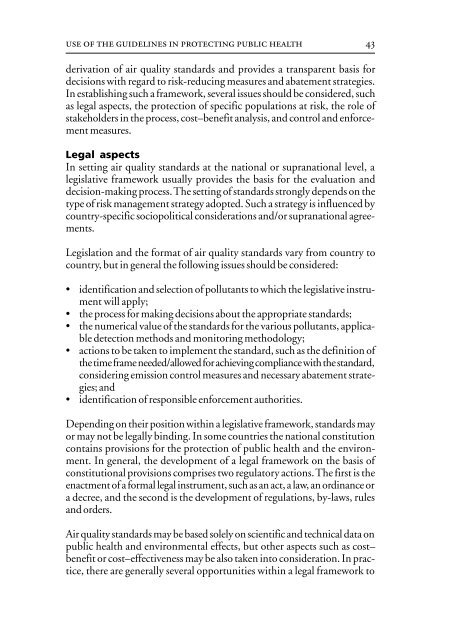Air Quality Guidelines - World Health Organization Regional Office ...
Air Quality Guidelines - World Health Organization Regional Office ...
Air Quality Guidelines - World Health Organization Regional Office ...
Create successful ePaper yourself
Turn your PDF publications into a flip-book with our unique Google optimized e-Paper software.
use of the guidelines in protecting public health<br />
derivation of air quality standards and provides a transparent basis for<br />
decisions with regard to risk-reducing measures and abatement strategies.<br />
In establishing such a framework, several issues should be considered, such<br />
as legal aspects, the protection of specific populations at risk, the role of<br />
stakeholders in the process, cost–benefit analysis, and control and enforcement<br />
measures.<br />
Legal aspects<br />
In setting air quality standards at the national or supranational level, a<br />
legislative framework usually provides the basis for the evaluation and<br />
decision-making process. The setting of standards strongly depends on the<br />
type of risk management strategy adopted. Such a strategy is influenced by<br />
country-specific sociopolitical considerations and/or supranational agreements.<br />
Legislation and the format of air quality standards vary from country to<br />
country, but in general the following issues should be considered:<br />
• identification and selection of pollutants to which the legislative instrument<br />
will apply;<br />
• the process for making decisions about the appropriate standards;<br />
• the numerical value of the standards for the various pollutants, applicable<br />
detection methods and monitoring methodology;<br />
• actions to be taken to implement the standard, such as the definition of<br />
the time frame needed/allowed for achieving compliance with the standard,<br />
considering emission control measures and necessary abatement strategies;<br />
and<br />
• identification of responsible enforcement authorities.<br />
Depending on their position within a legislative framework, standards may<br />
or may not be legally binding. In some countries the national constitution<br />
contains provisions for the protection of public health and the environment.<br />
In general, the development of a legal framework on the basis of<br />
constitutional provisions comprises two regulatory actions. The first is the<br />
enactment of a formal legal instrument, such as an act, a law, an ordinance or<br />
a decree, and the second is the development of regulations, by-laws, rules<br />
and orders.<br />
<strong>Air</strong> quality standards may be based solely on scientific and technical data on<br />
public health and environmental effects, but other aspects such as cost–<br />
benefit or cost–effectiveness may be also taken into consideration. In practice,<br />
there are generally several opportunities within a legal framework to<br />
43

















